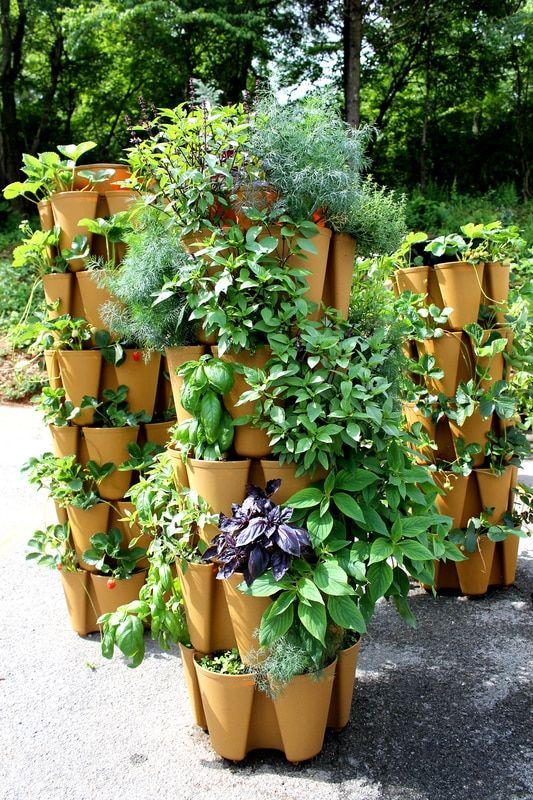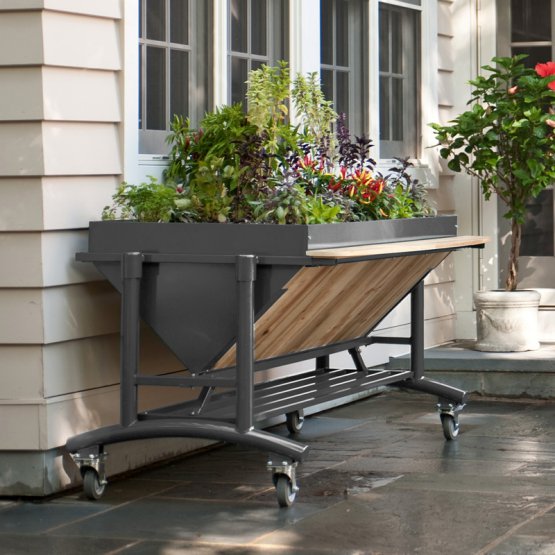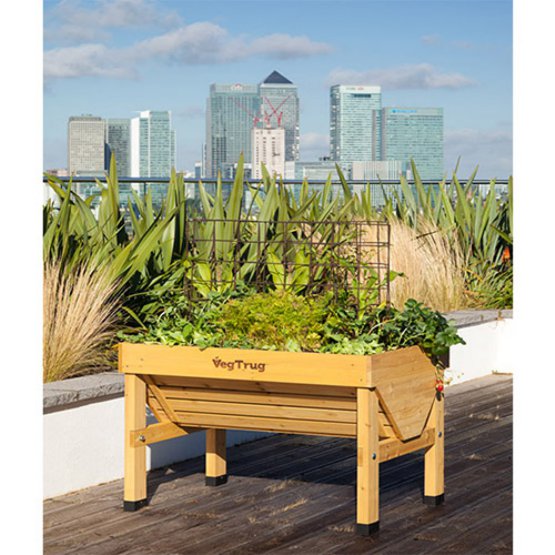There is a huge variety in the way we can grow food and flowers for our families:
- In the ground
- In raised beds
- In containers
 A lot of us – especially as we grow older – prefer to use either raised beds or containers, as they are easier to manage/control. We control the kind of soil, the space they take up, and they are easier to work in with a minimum or lack of stooping and crawling around on your hands and knees!
A lot of us – especially as we grow older – prefer to use either raised beds or containers, as they are easier to manage/control. We control the kind of soil, the space they take up, and they are easier to work in with a minimum or lack of stooping and crawling around on your hands and knees!
Of course, cost is a consideration, and we usually want whatever we use to look nice.
By the way, since I planted seeds this past weekend, my broccoli rabe seeds germinated and are growing fast, and I can see my basil seedlings peeking above the soil. Soon they will need a home!
I am getting a GreenStalk planter for my patio (more about that later) as a gift from my daughter for Mothers Day/my birthday, so I’ll be planting a lot in that. I have a variety of containers as well that I will be using. Obviously I won’t be growing enough vegetables and herbs to meet all of my produce needs.
If you want to use raised beds, there are many options. There are kits you can buy made from wood or metal, or you can build your own. Here is our friend Jess and her husband Jeremiah talking about how they built their raised beds on a shoestring budget:
The GreenStalk planters are manufactured in the USA (Tennessee). They come in various configurations, and you can order whatever you like/need. The one I am getting has five levels of the deep planting pockets in a terra cotta color, and we selected a base on locking wheels. If you are interested, here is their website: https://store.greenstalkgarden.com/






Those are some neat planters.
LikeLiked by 2 people
I also have a planter on legs (a cheap one), big pots and grow bags, which are a really inexpensive alternative to pots. I grew tomatoes in grow bags!
LikeLiked by 2 people
I’m going to do the kidee pool (2) number. Gonna do some peppers and a couple of tomaters! I have 2 stumps cut in the front yard that they can sit on! In constant sun!
LikeLiked by 2 people
Good idea, Pa!
LikeLike
A couple of years ago I started so many cherry tomato plants that I didn’t have enough planters to contain them. I had saved some plastic jugs that had contained kitty litter, cut the tops off, put in some drainage holes, and used them as planters. They worked really well.
LikeLiked by 3 people
Drainage holes are most important.
I got some plastic pots three seasons ago at the Dollar General: Terra cotta color, only cost $9.99 each. Put my plants in them and kept them well watered and supplied with Miracle Grow. They don’t produce as well as the ground, but nematodes and tomato wilt made the ground unsuitable for tomatoes, eggplant and peppers.
LikeLiked by 2 people
I love that one under the GreenStalk Planter pic. Love that GreenStalk type too, but our weeds grow too big for it, LOL. Have done raised beds – not so good here at my place, bucket gardening works pretty well…..trying to source about a dozen straw bales to try that method this year.
Fun stuff, and if you get edibles too – bonus!
LikeLiked by 3 people
Anyone seen the price of seeds tho? Stickershock! Do your research tho, most veggies seeds can keep several years stored properly – not so much the annuals….herbs and flowers. BUT, saving seeds isn’t all that complicated or hard either.
With fertilizer now becoming a worldwide scramble issue…..growing compost worms might he a good idea, as well as a compost pile…………many options there too – doesn’t have to be huge or smelly.
LikeLiked by 2 people
We throw all veggie remains, fruit peels, coffee grounds, eggshells etc. in the garden or under a tree. They disappear either by critters taking them or they melt into the dirt. Free compost with no effort. At first I grabbed bags of lawn clippings from people’s trash piles to make mulch under the plants, but started to worry what insecticides and herbicides might be in them.
LikeLiked by 2 people
In AU we would bury our kitchen scraps right into the garden beds or where any plants needed a boost. Can’t do that in Florida – the Possums, Coons and Armadillo will dig them up even if buried a foot or more down!
Critters will dig out our seedling pots for any seeds too if no cage around them until they get up a bit. I reckon that might be the squirrels tho….
LikeLiked by 2 people
When I was in S. Cal. back in the 70’s, I put anything we had leftover into the blender and then poured it about a foot away from the plants. It worked great and n nothing came after it. That excluded meats of course.
LikeLiked by 2 people
I have a good backlog of seeds from previous years, and they are germinating well. A good economical seed source is MIGardener.com. I ordered 6 packs today at 2.00 ea., with free shipping.
LikeLiked by 1 person
Thanks Stella – I’ve added them to my list of suppliers.
Looks like they package smaller amounts of seed per pack, but for most people that’s ok. Who needs 100 tomato plants unless they’re planning to feed the army!
LikeLiked by 1 person
You are welcome!
LikeLike
We will be slowly building what will be almost completely high raised beds for our gardening. Some things, like corn or anything that climbs, will still be planted at ground level or in low raised beds. I’m in my 50’s, my husband is physically disabled, and even my daughters have physical issues that make raised beds the way to go for us. I used found lumber to build the beds we currently have two types of fall garlic in, that are “only” 12 inches high, and even that made a HUGE difference in comfort. For mobility issues, we’ll be building beds between 3 and 4 feet high (I’m building them out of dead spruce trees we’ll be harvesting, so the size of the trunks will vary the heights of the beds). They will also be about 4 feet apart, to have enough space for a walker or wheelchair, and be able to turn around. Which also happens to be perfect to fit a wheelbarrow or wagon.
Most plants need only about 8-12 inches of soil to grown in, so low raised beds is more than enough for most people who aren’t physically disabled … yet… LOL (A friend of mine in the disabled community refers to people who aren’t disabled as TABs – Temporarily Able Bodied.) High raised beds have 2 major problems: filling all that space, and too much drainage. For us, we’re filling ours using modified hügelkultur methods, with the layer of wood on the bottom acting as a sponge, combined with Lasagna garden methods, with layers of organic matter, before finally topping off with garden soil and mulch. People I know who have done this did not have to water their beds more than once a week, even during our drought last summer, when we were watering our beds twice a day, every day. So hopefully, it’ll work! So far, we’ve just one one completed high raised bed. I need to cut more dead spruces down to build more. 😀
LikeLiked by 2 people
Good suggestions.
LikeLike